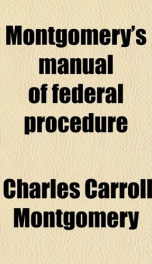montgomerys manual of federal procedure

Purchase of this book includes free trial access to www.million-books.com where you can read more than a million books for free. This is an OCR edition with typos. Excerpt from book: CHAPTER 4. JUDICIAL DISTRICTSTERMS AND PLACES OF HOLDING COURT IN THE SEVERAL STATES. 100. The United States. 101. Alabama. 102. Arkansas. 103. Arizona. 104. California. 105. Colorado. 106. Connecticut. 107. Delaware. 108. Florida. 109. Georgia. 110. Idaho. 111. Illinois. 112. Indiana. 113. Iowa. 114. Kansas. 115. Kentucky. 116. Louisiana. 117. Maine. 118. Maryland. 119. Massachusetts. 120. Michigan. 121. Minnesota. 122. Mississippi. 123. Missouri. 124. Montana. 125. Nebraska. 126. Nevada. 127. New Hampshire. 128. New Jersey. 129. New Mexico. 130. New York. 131. North Carolina, 132. North Dakota. 133. Ohio. 134. Oklahoma. 135. Oregon. 136. Pennsj'lvania. 137. Rhode Island. 138. South Carolina. 139. South Dakota. 140. Tennessee. 141. Texas. 142. Utah. 143. Vermont. 144. Virginia. 145. Washington. 146. West Virginia, 147. Wisconsin. 148. Wyoming. § 100. The United States. Chapter 5 of the Judicial Code, contained in our Appendix, deals with the subject-matter in this chapter contained. The chapter heading of the Code reads, "District CourtsDistricts, and Provisions Applicable to Particular States." !N"o district contains territory of more than one state, althougha state may contain more than one district, and always contains at least one.1 Judicial officers for these district courts are treated of in chapter 2. Their organization in other respects, special terms, adjournments, places of keeping records, reports of decisions, rules for admission to practice before, and their rules of practice, are treated in chapter 3. This chapter gives the territorial boundaries of the various divisions and districts in the several state...
Info about the book
Author:
Series:
Unknown
ISBN:
0557220025
Rating:
4/5 (3)Your rating:
0/5
Languge:
English
Users who have this book
Users who want this book
What readers are saying
What do you think? Write your own comment on this book!
write a commentif you like montgomerys manual of federal procedure try:
Other books by this author
Do you want to exchange books? It’s EASY!
Get registered and find other users who want to give their favourite books to good hands!


